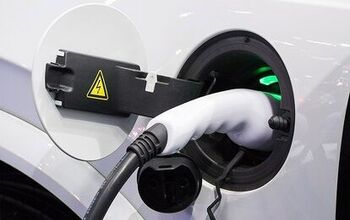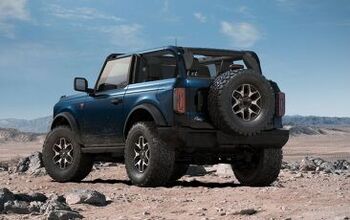Worth the Weight?
Obesity is rampant in America. Between the Center for Disease Control’s dire reports, documentaries like “Honey We’re Killing the Kids” and endless infomercials for every diet and exercise program imaginable, it’s obvious we’re becoming a nation of Fat Bastards and Sherman Klumps. Now the Environmental Protection Agency is sounding the alarm about our cars. The EPA recently announced that America’s vehicle fleet is the heaviest it’s been since Ford touted the Pinto’s “road hugging weight” as a safety feature. Our cars and trucks, like their drivers, are piling on the pounds.
Let's face it: most vehicles sold in America are obese. Today’s average car is portlier than a binge-eating sumo, while your standard issue full-size SUV weighs as much as a fully-grown hippopotamus. In 1987, the U.S. fleet average was 3220 lbs. In 2006, the average US vehicle tips the scales at a scarcely credible 4142 lbs. In a time of high gas prices, when we should be building cars that eke out the last mpg, this makes no sense at all. Or does it?
In the intervening years, federally mandated safety equipment and the commercial importance of crash test ratings have added weight to America’s fleet. But, in 2001 (the last year where I could find applicable data), safety equipment accounted for only 125 lbs. of an average vehicle’s total weight. It’s risen since then, but even if you double this figure it’s still a far cry from the over 900 lbs. increase over the past 19 years.
Clearly, manufacturers have met passive safety requirements without resorting to simple fortification. In fact, the weight gain comes in spite of an upsurge in lighter-weight automotive materials. Cars were once built almost entirely out of ferrous materials; today’s vehicles are constructed with less than 65% steel. The remainder consists of materials like plastic, aluminum, magnesium, titanium and balsa wood. Yet vehicles keep adding poundage.
Of course, it takes energy to move all this mass around. While most manufacturers meet federal Corporate Average Fuel Economy standards (save fine-paying miscreants like BMW), almost every single carmaker has shown a lamentable decrease in overall fuel economy during the past three years. As weight goes up, so does fuel consumption. It doesn’t take a genius to figure that one out, so why can’t carmakers cut the crap? Why aren’t they doing more to decrease the weight of their products across the board?
The bottom line is the bottom line. The auto companies are in business to make money (Ford’s and GM’s recent performances notwithstanding). Large SUV’s and pickups are far more profitable than passenger cars. Automakers have been doing everything they can to push as many of these money-makers into the hands of the consumer as possible. Until recently, the car-buying public rushed to them like bomb shelters in Baghdad, oblivious to their appetite for Jurassic juice. As car makers sold entire flotillas of big-ass behemoths, they’ve driven the average weight stats higher and the fuel economy averages lower.
Consumers who wouldn’t even think of buying an SUV or pickup truck are also contributing to the trend toward excess automotive avoirdupois. Once upon a time, electric windows, remote alarms and power door locks were a luxury. Just ten years ago, sunroofs, automatic climate control and sat nav systems were restricted to luxury cars. Today, all these toys are available in the most basic econobox, and a “necessity” in any car with upmarket pretensions. Extra goodies, extra weight. No wonder the two-door Honda Civic has porked-up nearly 400 pounds over the past 10 years.
So what’s the solution to this weighty problem? U.S. car makers must get serious about slimming down. Earlier this summer, several automakers established weight targets for parts and asked suppliers to redesign them accordingly. That’s an excellent step in the right direction, but they need to go further. Every manufacturer redesigning their products– from economy cars to mid-size sedans to full-size SUV’s– needs to make weight loss a top priority. They should trim vehicle weight by at least 20% while maintaining utility. And why not? In 1977, GM downsized their entire full-sized passenger car lineup and watched sales go up. It’s time for an encore.
The American Plastics Council estimates every 10 percent reduction in weight delivers a seven percent increase in fuel efficiency. If the 5342 lbs. Chevrolet Tahoe lost 20% of its fat, urban mpg would rise from 16 to 18.24 mpg. But fuel economy isn’t the only benefit. Can you image thrashing a Pontiac Solstice that weighed 500 lbs. less? Or how much more tossable a Honda Civic hatchback would be with today’s power at ‘96’s weight? For pistonheads, “road hugging weight” is as undesirable today as it was in the 70’s. No matter how you look at it, it’s time for all U.S. vehicles to go on a diet.
More by Frank Williams
Latest Car Reviews
Read moreLatest Product Reviews
Read moreRecent Comments
- Rochester I'd rather have a slow-as-mud Plymouth Prowler than this thing. At least the Prowler looked cool.
- Kcflyer Don't understand the appeal of this engine combo at all.
- Dave M. This and the HHR were GM's "retro" failures. Not sure what they were smoking....
- Kcflyer Sorry to see it go. The interior design and color options in particular are rare in the industry
- Wolfwagen Here is my stable. not great not bad I try to do as much as possible. I work for an Aftermarket automotive parts company so I can get most parts at a discount.i try to do as much of my own work as possible. My wife hates that I spend time and money fixing the vehicles but she doesn't want car payments either so...2019 VW Atlas 50K (wife's) Only issues so far were Brakes and normal maintenance.A Bad Cat Converter which was covered and a replacement of the rear bank head gasket which was a manufacturing defect due to improper torquing at the factory. All under warranty2003 Saab 9-5 Arc Wagon (my DD) 116 K picked up used last year. Replaced Struts, brakes, hatch struts, motor mounts, D/S swaybar link, Timing belt, water pump and thermostat Power steering pump Fuel pump, Both Front window regular rollers, Heater core and cabin air filter. Oil and transmission changes. Love the car but Saab/GM packaging is a nightmare.2005 Cadillac Deville (former DD now Son # 1 DD) picked up used 5 years ago with only 47K now 83K Plugs, coils, P/s pump, Water pump, hoses, P/S lines (mechanic job) evap valve, brakes, Front brake calipers and rear brake calipers. Currently has oil pan gasket leak - looking to have a mechanic do that2009 Mini Cooper (Daughters dd)picked up 2 years ago 67K Brakes and thermostat house to clear check engine light2001 Mazda Tribue (Son#2 dd) 106K picked last summer after he severely damaged a 2004 Hyundai accent. Oil changes


































Comments
Join the conversation
A psychologist friend of mine believes that all the safety equipment in todays' cars makes them LESS SAFE. His reasoning is that drivers will take many more chances, chances they wouldn't normally take, because they put too much faith in all the safety systems in a car. He says that if you want to see safer driving, instead of putting in airbags in the steering wheel, they should put a sword facing the driver there.
at 6'3" and well into the deepside of 200 lbs (football player). . .i have managed to fit myself into a lotus exige. . .it was sure a challenge, but not impossible. . . you can fit into a civic!